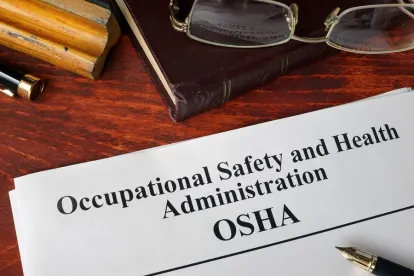It’s that time of year again…when federal agencies, including OSHA, tell us what is on the horizon for rulemaking activity. This week the spring semiannual regulatory agenda for federal agencies was published. This Regulatory Agenda provides a complete list of all regulatory actions that are under active consideration for promulgation, proposal, or review and covers regulatory actions for over 60 federal departments, agencies, and commissions.
The Regulatory Agenda for the Department of Labor includes a total of twenty regulatory entries for OSHA specific actions. In this year’s regulatory agenda there are nine regulatory actions in the pre-rule stage, which is consistent with the 2018 fall agenda. Five of the regulatory actions are in the proposed rule stage and six of these specific actions are in the final rule stage.
This year it is less about what is on the short term regulatory agenda and more about what has quietly appeared on the agency’s long term regulatory agenda. As part of the agency’s long term regulatory agency rulemkaing OSHA announced rulemaking activity for “Drug Testing Program and Safety Incentives Rule.” It appears that OSHA is attempting to revise a portion of the recently promulgated electronic recordkeeping rule (Improve Tracking of Workplace Injuries and Illnesses) to codify the agency’s position on safety incentive programs and drug testing.
In October 2018, in a memorandum to Regional Administrators, OSHA clarified the agency’s position as to whether certain drug testing policies or safety incentive programs would be considered violations of part 29 C.F.R. § 1904.35(b)(1)(iv). In that memorandum, OSHA stated that
“29 C.F.R. § 1904.35(b)(1)(iv) does not prohibit workplace safety incentive programs or post-incident drug testing. The Department believes that many employers who implement safety incentive programs and/or conduct post-incident drug testing do so to promote workplace safety and health. In addition, evidence that the employer consistently enforces legitimate work rules (whether or not an injury or illness is reported) would demonstrate that the employer is serious about creating a culture of safety, not just the appearance of reducing rates. Action taken under a safety incentive program or post-incident drug testing policy would only violate 29 C.F.R. § 1904.35(b)(1)(iv) if the employer took the action to penalize an employee for reporting a work-related injury or illness rather than for the legitimate purpose of promoting workplace safety and health.”
OSHA has now included revising 29 C.F.R. § 1904.35(b)(1)(iv) to the regulatory agenda in an effort to memorialize its position. According to the regulatory agenda, “OSHA recently clarified, through a memorandum to the field, the agency’s position that 29 CFR 1904.35(b)(1)(iv) does not prohibit post-incident drug testing or safety incentive programs. The agency would propose memorializing OSHA’s position on these issues through changes to 29 CFR 1904.35(b)(1)(iv) related to implementation of post-incident drug testing and safety incentive programs.” The regulatory agenda identifies an anticipated date of September 2020 for the issuance of a Notice of Proposed Rulemaking.
Additional regulatory actions under consideration by OSHA include:
|
RULE |
ANTICIPATED AGENCY ACTION |
|
|
Communication Tower Safety |
Complete SBREFA May 2019 |
|
|
Emergency Response |
Initiate SBREFA May 2019 |
|
|
Lockout/Tagout |
Request for Information May 2019 |
|
|
Tree Care |
Initiate SBREFA June 2019 |
|
|
Update to the Hazard Communication Standard |
Notice of Proposed Rulemaking September 2020 |
|
|
Initiate SBREFA October 2019 |
|
|
Occupational Exposure to Beryllium and Beryllium Compounds in Construction and Shipyard Sectors |
Final Rule December 2019 |
The full federal Unified Agenda and Regulatory Plan can be found online.




 />i
/>i

